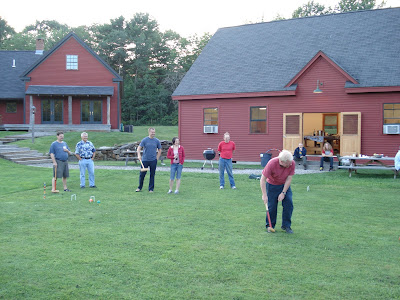
DAY FIVE started perfectly, condensation wasn't dripping down the window in my room, there was a light breeze, birds chirping, and the sun was shining. Then 2 o'clock came and with it dark clouds and an endless rain, though, when you're woodworking the weather doesn't matter that much.

We drafted our project design most of the morning. Our inspiration is a shaker bench with wedged tenons and dovetails and our only instruction is that we have to change one of the dimensions by at least 1/8 of an inch. That was no problem for most of us. Francis designed a bench using measurements that were prime numbers between 1 and 23. Bill is keeping his bench fairly simple but focusing on wood selection and grain pattern. We all have our own philosophy's and inspirations and the school lets you follow it through. This can definitely be seen when you visit the Fellowship Fellows who are all doing something completely different from the other, but all amazing. I still haven't had a chance to take pictures and post about the different Fellows, but perhaps I'll find some time on Sunday. I realized quickly The Center For Furniture Craftsmanship has a lot to offer. A 10 minute stroll through the campus exposes you to thousands of hours worth of work in such a range that you can't help but be inspired.
Discussing Design (Allen, Bill P., Aaron, Marie)
Marie, our interior designer
Pen to paper we all hash out our ideas for the bench (L to R: Bill B., Daniel, Marie, Sybil, Bill P., and Francis)
With our benches designed and drafted our after lunch lecture was on wood selection. How to buy it, how to lay it out, why you should pay attention to grain and layout, yada yada yada.
PK giving us the ins and outs of wood selection. (I almost got the whole class in this one)

Drafting and wood selection are nice, but nothing compares to HAND PLANING. Hand planing is the process of shaving away wood using a hand plane to get it flat. Sounds kind of easy right, well if you've been reading the blog you'll know there isn't anything easy here. It took me about 6 hours, 2 liters of water, and a pretty big blister on the palm of my hand before I could say I flattened the first side one board. Sounds exciting right, well actually it is.
The process is pretty intensive,
Step 1: You have to check to see where the wood is bowing and use a Scrub Plane to make a very slight concavity in the wood being sure to cut across the grain so you don't get tear out.
The board before
About an hour of scrub planing later.
Step 2: Use a #5 (or whatever) and plane across the grain until you taken out any twist and get the board flat from side to side.
30 minutes later its coming together.
Step 3: Once the width of the board is flat, plane the length.
45 minutes later, for a total of 2 hours 15 minutes, a hand planed face and worth every callus. Now it's time for the other side.



























































